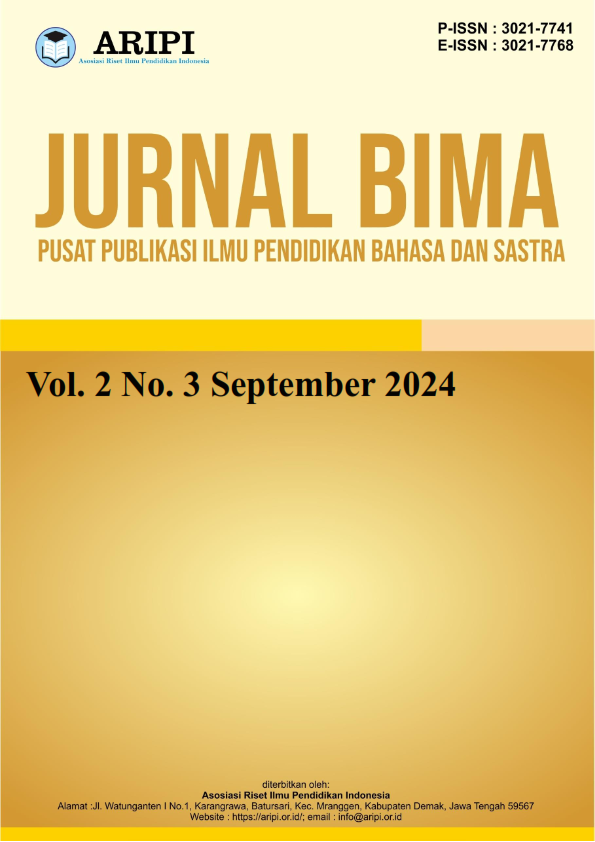Applying English Songs To Children In Second Language Acquisition
DOI:
https://doi.org/10.61132/bima.v2i3.1018Keywords:
Children, Songs, Second Language AcquisitionAbstract
This research explores the use of English songs as an aid in second language acquisition (SLA) among children. Utilizing a qualitative method with a case study approach, this study observes the responses and language progress in a group of young children learning English through songs as a whole, to provide a comprehensive understanding. The results show that English songs significantly improve children's listening skills, vocabulary, and pronunciation. Through a fun and interactive approach, songs help children overcome emotional barriers in learning a new language, creating a supportive and less stressful learning environment. Additionally, the rhythm and repetition in songs facilitate the memorization and understanding of new words and phrases. The study also found that children are more motivated and show greater interest in learning English when using songs. Therefore, the application of English songs is recommended as an effective strategy for teachers and language instructors to support second language development in children. This study underscores the importance of innovation in language teaching methods and supports the use of musical media as an educational tool that positively impacts children's linguistic development.
Downloads
References
Brewster, J., Ellis, G., Girard, D. (2002). The Primary English Teacher’s Guide. England: Penguin English.
Brown, R. (1973) A First Language. Cambridge: Harvard Press.
Brown, R. and C. Hanlon (1970) "Derivational complexity and order of acquisition in child speech." In J. Hayes (Ed.), Cognition and the Development of Language. New York: Wiley, pp. 155-207.
Brown, R., C. Cazden, and U. Bellugi (1973) "The child's grammar from I to III." In C. Ferguson and D. Slobin (Eds.), Studies of Child Language Development. New York: Holt, Rinehart, and Winston, pp. 295-333.
Cheeks, Steve. (2014). Songwriting Tips: 10 Elements of a Song https://www.songwriting.net/blog/bid/207465/Songwriting-Tips-10-Elements-of-a-Song
Dulay, H. and M. Burt (1975) "A new approach to discovering universal strategies of child second language acquisition." In D. Dato (Ed.), Developmental Psycholinguistics: Theory and Applications. Georgetown University Round Table on Languages and Linguistics. Washington: Georgetown University Press, pp. 209-233.
Espinosa, L. (2014). Second Language Acquisition in Early Childhood. https://www.researchgate.net/publication/265075052
Fachraini, S., Bina, S., & Getsempena, B. (2017). Using English Songs to Increase Early Students’ Vocabulary. In Getsempena English Education Journal (GEEJ) 4(2).
Hornby, A.S. (1990). Oxford Advanced Learner’s Dictionary of Current English. Oxford: Oxford University Press.
Irawan, D. (2019). THE SECOND LANGUAGE ACQUISITION IN THE FIFTH GRADE STUDENT OF SDN UJUNGARIS 1 INDRAMAYU. In Faktor Jurnal Ilmiah Kependidikan 6(1).
Jannah, M., Fitriani, R., & Dewi, L. S. (n.d.). The Differences Between Childrens vs Adults in Second Language Aquisition.
Journal, T. (2018). Children and Adults in Second-Language Learning Hadna Suryantari. 6(1), 30–38.
Khasinah, S. (2014). FACTORS INFLUENCING SECOND LANGUAGE ACQUISITION 1(2).
Nurul Fitria, S., Nopiyanti, D., & Suciati Dewi, L. (2023). An Analysis of Children Vs Adults in Second Language Acquisition. 02. https://youtu.be/oZ6qN4RpuBo
Snow, C. and C. Ferguson (1977) (Eds.) Talking to Children: Language Input and Acquisition. Cambridge: Cambridge University Press.
Downloads
Published
How to Cite
Issue
Section
License
Copyright (c) 2024 Jurnal Bima : Pusat Publikasi Ilmu Pendidikan bahasa dan Sastra

This work is licensed under a Creative Commons Attribution-ShareAlike 4.0 International License.






